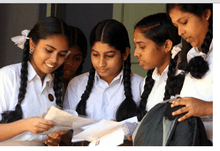Secondary School Leaving Certificate
The Secondary School Leaving Certificate (commonly referred to as SSLC) is a certification obtained by a student on successful completion of an examination at the end of study at the secondary schooling level in India. The SSLC is obtained on passing the grade 10 public examination, which is commonly referred to as 'class 10 board examinations' in India. SSLC is a common eligibility examination popular in international markets many states in India, especially Kerala, Karnataka, and Tamil Nadu.
Relevance

The Indian system of education fundamentally consists of five years of primary schooling, followed by five years of secondary schooling.[1] The SSLC must be obtained at the end of term of study at the secondary school.
On obtaining this certificate, the student is deemed to have completed his basic schooling or basic education. After successful completion of SSLC, a student wishing to pursue their education further joins a course based on the specialisation their choosing, which gives them knowledge sufficient to enter a university which is sometimes called a Pre-University Course (PUC), for two years. After this period of study a student may enter a university for undergraduate studies.
Alternatively, after obtaining the SSLC, a student may choose to attend an industrial training institute where one can be trained in skills necessary for technical occupations.[2] The other options include joining polytechnic for a three-year course of diploma in engineering and then further pursuing degree in engineering. After completing SSLC there is an option of joining vocational education courses. SSLC (or equivalent) is required nowadays to obtain a passport under Indian government for employment purposes.
Importance
The SSLC certificate was used as the primary form of proof for date of birth during the time when registration of births and deaths was not mandatory in India. It is still a valid form of proof of date of birth for those born before 1989[3] according to the MEA website[4] for the Indian civil authorities to issue civil documents such as passports.
See also
- Central Board of Secondary Education (CBSE), India
- National Institute of Open Schooling (NIOS), India
- Council for the Indian School Certificate Examinations (CISCE), India
- Kerala State Education Board
- Bihar School Examination Bord (BSEB), PATNA . India
References
- "School education in Karnataka". www.schooleducation.kar.nic.in. Retrieved 20 January 2010.
- "Trades minimum qualifications". http://emptrg.kar.nic.in. Archived from the original on 10 April 2009. Retrieved 20 January 2010. External link in
|publisher=(help) - Ministry of External Affairs, Website. "Proof of Date of Birth" (PDF).
- Ministry of External Affairs, Website. "Main site".